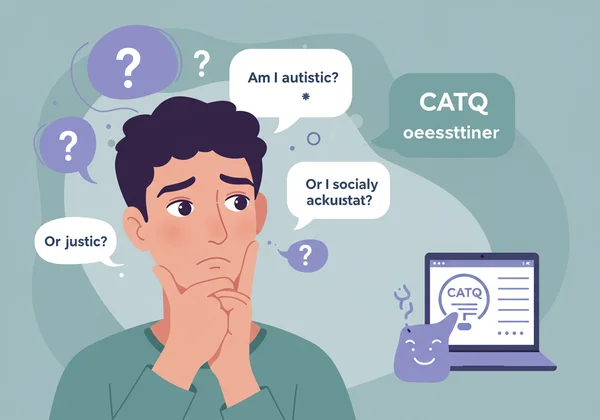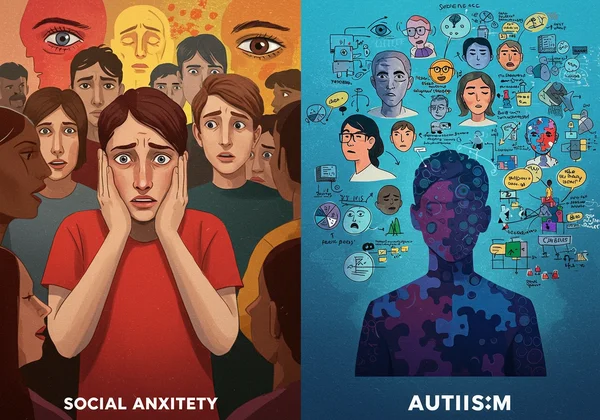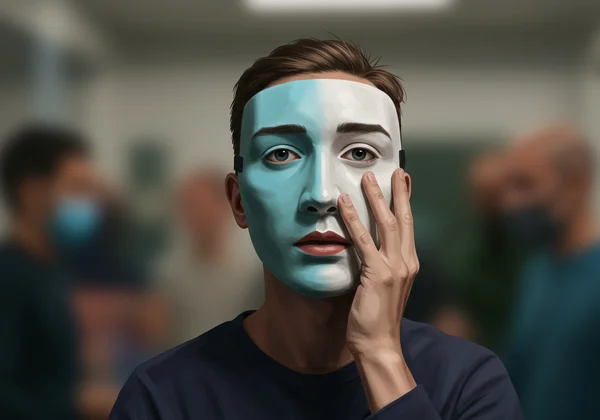The CATQ: Untangling Autistic Camouflaging, Autism, and Social Anxiety
Feeling socially awkward is a near-universal human experience. But for some, it's more than just occasional shyness; it's a persistent, exhausting state of confusion and self-doubt. You might find yourself constantly wondering, Am I autistic or just socially awkward? This question is incredibly common, especially for adults who have spent their lives feeling "different" without knowing why. The confusion often stems from a powerful, unconscious strategy: autistic camouflaging. Understanding this can be the key to unlocking clarity, and the CATQ (Camouflaging Autistic Traits Questionnaire) is a vital tool on that journey. If you're ready to move past confusion and toward self-understanding, you can start your assessment today.

Autism vs. Social Anxiety: Key Distinctions
At a glance, the outward signs of autism and social anxiety can look strikingly similar: avoiding social events, struggling with small talk, and feeling drained after interactions. However, the internal motivations and underlying reasons for these behaviors are fundamentally different. Distinguishing between them is the first step toward accurate self-awareness.
What is Social Anxiety? Fear of Social Situations
Social Anxiety Disorder is primarily driven by an intense, persistent fear of social situations. The core of this anxiety is the fear of being watched, judged, or scrutinized by others. A person with social anxiety worries they will say or do something embarrassing, leading to rejection or humiliation.
This fear can manifest physically with symptoms like a racing heart, sweating, or trembling. The avoidance of social gatherings isn't due to a lack of understanding social rules, but rather a profound fear of failing to meet perceived social expectations. The mental energy is spent anticipating negative outcomes and worrying about what others are thinking.
What is Autism? Understanding Social Interaction Differences
Autism, on the other hand, is a neurodevelopmental difference. It affects how a person experiences the world, communicates, and interacts with others. For an autistic person, social challenges are not typically rooted in a fear of judgment but in inherent differences in social processing. This might include difficulty interpreting non-verbal cues like body language or tone of voice, a preference for direct communication, and a different understanding of unspoken social rules.
Many autistic people genuinely want to connect with others but find the "how" to be confusing or unnatural. The exhaustion they feel after socializing—often called an 'autistic burnout'—comes from the immense cognitive effort required to consciously process social information that neurotypical people handle intuitively. This is particularly true for individuals with undiagnosed autism in adults, who have never had a framework to understand their experiences.

How Autistic Camouflaging Blurs the Lines
Here is where the lines get blurry. Many autistic people, especially those diagnosed later in life, develop sophisticated strategies to hide their autistic traits and appear neurotypical. This is known as autistic camouflaging or masking. They learn to perform social norms, effectively creating a mask that can look a lot like social anxiety.
An autistic person who is camouflaging might avoid social events not because they fear judgment, but because they lack the energy to perform the role of a "normal" person for several hours. They might appear anxious because they are manually calculating when to smile, how much eye contact to make, and what to say next. This constant self-monitoring is incredibly stressful and can easily be mistaken for social anxiety. Exploring your own masking behaviors with a free online test can provide valuable insights.
Signs of Autistic Camouflaging & Masking Behaviors
Recognizing these behaviors in yourself can be a lightbulb moment. Signs of autistic camouflaging are often subtle coping mechanisms that have become second nature over years of practice. How do I know if I'm masking autism? You might recognize some of the following:
- Scripting conversations: Mentally rehearsing what you’re going to say before and during social interactions.
- Mimicking others: Copying the gestures, facial expressions, or phrases of people you're with to blend in.
- Forcing eye contact: Consciously reminding yourself to look at people, even if it feels uncomfortable or unnatural.
- Hiding special interests: Downplaying or not talking about your deep passions for fear of being seen as weird or obsessive.
- Creating a "persona": Developing a different personality for work, school, or social events that feels separate from your true self.
- Pushing through sensory discomfort: Enduring overwhelming lights, sounds, or crowds to avoid drawing attention to yourself.

Compensation, Masking, Assimilation: Decoding Your Camouflage Style
The scientific framework behind the CATQ breaks down camouflaging into three key areas. Understanding your unique style can help you pinpoint exactly where your energy is going.
- Compensation: This is the strategic side of masking. It involves learning social rules intellectually, like an actor learning lines. You might use techniques like watching movies to learn how people interact or developing a set of pre-planned jokes and stories for social situations.
- Masking: This involves actively hiding your autistic traits. It’s about suppressing natural behaviors, such as stimming (rocking, hand-flapping), and forcing yourself to perform neurotypical ones, like making consistent eye contact.
- Assimilation: This is the desire to fit in and be accepted. It’s the feeling of trying to become someone else entirely in social settings, often leading to a sense of lost identity. The debate around masking vs assimilation autism highlights how one is about hiding traits while the other is about trying to fully adopt a different persona.
Am I Autistic or Just Socially Awkward? Your Path to Clarity
Ultimately, only you can untangle your own experiences. However, armed with the right knowledge and tools, you can move from a place of confusion to one of empowered self-understanding. The goal isn't to find a label but to find a framework that validates your lived reality and helps you live more authentically.
Self-Reflection: Questions to Consider for Deeper Understanding
Take a moment to reflect on your social experiences. Instead of asking if you're "awkward," ask why you feel that way. Can I be autistic and not know it? It's entirely possible. Consider these questions:
- When you leave a party feeling exhausted, is it because you were worried about what people thought of you, or because you were manually processing every single interaction?
- Do you avoid social events because you fear judgment, or because you lack the energy for the performance required to attend?
- As a child, did you feel like you got a "social rulebook" that everyone else was born with?
- Do you feel a profound sense of relief when you are alone and can finally "drop the mask"?
The CATQ Test: A Scientifically Validated Tool for Self-Assessment
Self-reflection is powerful, but sometimes you need objective data to validate your feelings. This is where the CATQ test comes in. Developed by researchers (Hull et al., 2018), the Camouflaging Autistic Traits Questionnaire is a scientifically validated tool designed specifically to measure the degree to which you engage in camouflaging behaviors.
The CATQ online test available on our platform provides a safe, private, and accessible way to quantify your experiences. It asks 25 questions about your social strategies and feelings. Your results will give you a total score and breakdown across the three subscales: Compensation, Masking, and Assimilation. This isn't a diagnostic tool, but it is an incredibly powerful resource for self-exploration. It can give you the language and data to understand your own unique social landscape.

Embracing Self-Understanding: Your Next Steps Beyond the Labels
The line between autism and social anxiety is often blurred by the complex act of camouflaging. Untangling them isn't about fitting neatly into a box; it's about understanding the "why" behind your social experiences. Recognizing that your exhaustion may come from the cognitive load of masking—not from a fear of judgment—can be life-changing. It reframes your struggles not as a personal failing, but as a testament to your resilience.
This journey of self-discovery empowers you to make conscious choices about where you spend your energy, how you interact with others, and how you can live a more authentic life. If this article resonates with you, your next step is clear. Gain clarity by taking the free, scientifically-validated CATQ test on our homepage. Discover your camouflaging profile and begin the journey back to yourself.
Frequently Asked Questions About Autism, Anxiety, and Camouflaging
What are the signs of autistic camouflaging?
Common signs include rehearsing conversations, forcing or faking facial expressions, mimicking the social behavior of others, suppressing stims (like fidgeting or rocking), and intentionally avoiding topics you're deeply interested in to appear "normal." Many people who camouflage report feeling completely drained after social interactions.
How do I know if I'm masking autism?
A key indicator is a significant difference between how you act in public and how you feel or act when you are alone. If you feel like you are "performing" in social situations and need extensive recovery time afterward, you may be masking. Taking a self-assessment like the CATQ test can provide a structured way to explore these behaviors.
Can I be autistic and not know it?
Absolutely. This is especially common for women, trans and non-binary people, and individuals who did not have significant support needs as children. If you've spent your life feeling different and have developed strong camouflaging skills, your autistic traits may have been overlooked by yourself and others.
What is the difference between masking and camouflaging?
The terms are often used interchangeably. "Camouflaging" is the broader, research-based term that encompasses all strategies used to hide autistic traits. "Masking" is a component of camouflaging that specifically refers to hiding or suppressing natural behaviors and performing more neurotypical ones.
What is a high score on the CATQ?
The CATQ is scored out of 150. Research indicates that a total score of 100 or above is a strong indicator of significant camouflaging. However, any score can provide valuable information. It's important to consider your total score alongside the sub-scores (Compensation, Masking, Assimilation) to understand your unique camouflaging style. For a detailed breakdown, you can understand your score on our platform.